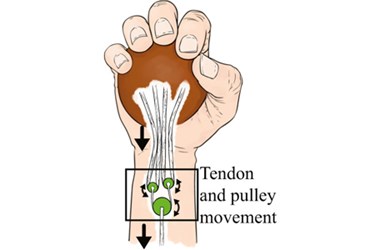Implantable Pulley Could Mechanize Human Hands
By Chuck Seegert, Ph.D.

By testing a new robotic system on cadavers, Oregon State University (OSU) researchers have successfully demonstrated the efficacy of an implantable pulley system for restoring function to hands that have suffered nerve damage. The novel device may also be useful for other joints in the body.
In certain cases of nerve damage, the hand may lose its ability to grip objects. Current repair procedures called tendon transfer procedures can restore some function to the hand. Basically, the finger tendons are removed from the paralyzed muscles and reattached to still-functioning muscle further up the arm, according to a recent press release. Unfortunately, however, after the tendon transfer procedure, the hand function is still somewhat limited due to the large forces required to activate the tendons.
“Many people have lost the functional use of their hands due to nerve damage, sometimes from traumatic injury and at other times from stroke, paralysis or other disorders,” said Ravi Balasubramanian, an assistant professor at the OSU College of Engineering, in the press release. “The impact can be devastating, since grasping is a fundamental aspect of our daily life.”
Testing of the new apparatus was conducted in a cadaver model according to a study the team recently published in the journal Hand. With the new method, the fingers of the tendons are sutured directly to a pulley mechanism, which is then secured to the extensor carpi radialis longus (ECRL) muscle. A control group was sutured directly to the ECRL muscle. Force measurements obtained by pulling on the ECRL revealed that the new device reduced forces required to flex the finger by up 45 percent. Additionally, fingers in the hands with the implant were more likely to adapt to an object’s contours when it was grasping. Slip was also reduced by 52 percent due to the implant.
While this testing was first done in the hand, the team hopes to extend it to other applications.
“We’ll still need a few years to develop biocompatible materials, coatings to prevent fibrosis, make other needed advances and then test the systems in animals and humans,” Balasubramanian said in the press release. “But working at first with hands — and then later with other damaged joints such as knees or ankles — we will help people recover the function they’ve lost due to illness or injury.”
While this device was not strictly robotic, the team involved is part of OSU’s rapidly expanding robotics research and education program, which includes fields ranging from robotic underwater vehicles to prosthetic limbs. Robotics in prosthetics is an area of biomedical science that is currently gaining momentum. Recently in an article published on Med Device Online, the FDA’s approval of a robotic arm was discussed.
Image Credit: Ravi Balasubramanian
